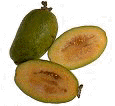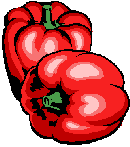|

Also call: Pineapple Guava,
Brazilian Guava
 | DESCRIPTION
|
Feijoa is like an oval shaped like the size of the duck's egg. The flesh inside is
yellow-green colour with a grainy texture with the centre like a jelly. It gives a scented
smell of pineapple and strawberry.
 | HISTORY AND ORIGIN
|
There was a Portuguese botanist who first explored Brazil by the name of Don de
Silva Feijoa, who found and named the fruit after himself. It is mainly originated from
South America. Nowdays it is grown in Australia and New Zealand.
 | BUYING AND STORAGE
|
There are only found in the shops during Autumn. Select feijoas with dark green
skin. They are soft and fragrant when ripe, and the skin will turn into a greenish-yellow
colour.It can be ripen at room temperature and kept in the refrigerator for up to 2 days.
 | PREPARATION AND USE
|
Feijoas can be peel, slice or chop. There can also be eaten fresh from the skin
with a spoon.The seeds are edible. Feijoas gives a sweet pineapple-mint flavour. It's an
excellent fruit for salad, jam, pureed and ice cream.
 | NUTRITIONAL INFORMATION
|
Feijoas provides a good source of fibre and a very excellent source of vitamin C.
 | MAJOR NUTRIENTS
|
- * SERVING SIZE: 100 grm
| * ENERGY: |
200 grm |
* IRON: |
|
| * PROTEIN: |
1
grm |
* POTASSIUM: |
|
| * FAT: |
|
* CALCIUM: |
|
| * CARBOHYDRATE: |
13
grm |
* VITAMIN A: |
|
| * DIETARY FIBRE: |
3 grm |
* VITAMIN B: |
|
| * SODIUM: |
|
* VITAMIN C: |
30
mg |
|




